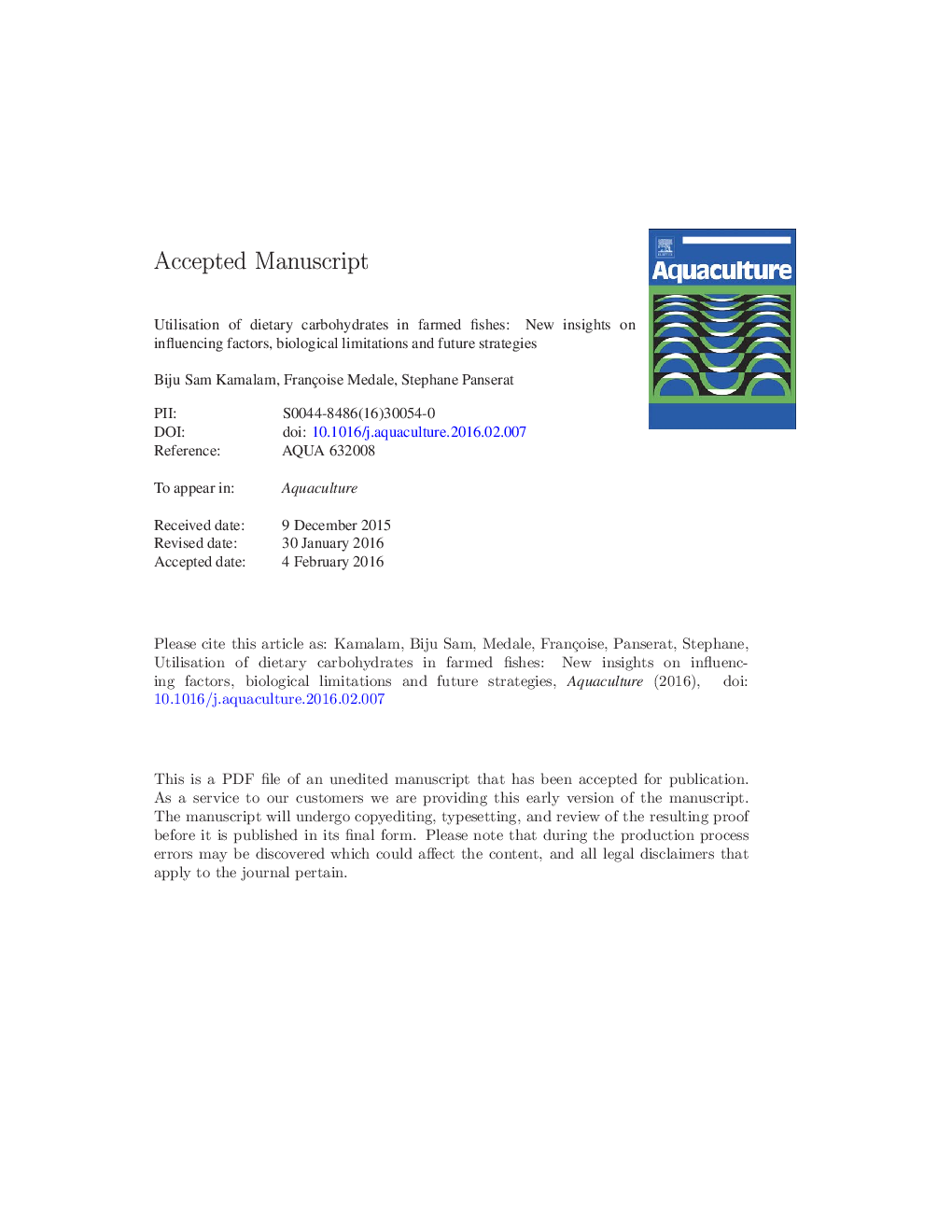| کد مقاله | کد نشریه | سال انتشار | مقاله انگلیسی | نسخه تمام متن |
|---|---|---|---|---|
| 5539511 | 1552820 | 2017 | 96 صفحه PDF | دانلود رایگان |
عنوان انگلیسی مقاله ISI
Utilisation of dietary carbohydrates in farmed fishes: New insights on influencing factors, biological limitations and future strategies
ترجمه فارسی عنوان
استفاده از کربوهیدراتهای رژیمی در ماهی های پرورش ماهی: بینش های جدید در مورد عوامل موثر، محدودیت های بیولوژیکی و استراتژی های آینده
دانلود مقاله + سفارش ترجمه
دانلود مقاله ISI انگلیسی
رایگان برای ایرانیان
کلمات کلیدی
مصرف کربوهیدرات، رژیم غذایی، ماهی، عدم تحمل گلوکز، متابولیسم، تغذیه،
ترجمه چکیده
کربوهیدرات ها از مواد غذایی غنی از انرژی هستند که از لحاظ اقتصادی در فرمولاسیون خوراک ماهی تجاری ضروری است. اما توانایی ماهی های زراعی برای استفاده از انرژی از اشکال قابل هضم کربوهیدرات، با توجه به عادات تغذیه، ویژگی های تشریحی فیزیولوژیکی و شرایط پرورش آنها اختلاف نظر دارد. به ویژه ماهیهای گوشتخوار به دلیل مصرف کم گلوکز روده و کاهش آرام گلوکز خون، از مصرف کربوهیدراتهای رژیمی کمبود دارند. از این رو، آنها بیشتر مطالعات را بر روی تغذیه و متابولیسم کربوهیدرات متمرکز کرده اند. یافته ها اغلب نشان می دهد حضور تقریبا تمام عناصر بیولوژیک ضروری، اما با تفاوت در مکانیسم قانونی است. از سوی دیگر، روند تغییرات در تغذیه ماهی با فرمولبندی به طور قابل توجهی بالاتر از ترکیبات گیاهی، کربوهیدرات های بیشتری را به وجود می آورد و نیاز به استراتژی های مقابله ای در ماهی دارد. در این چارچوب آبزی پروری، بررسی ما قصد دارد با استفاده از بینش جدیدی که در رابطه با 1) عوامل مختلف بیولوژیکی، تغذیه ای و محیطی که بر استفاده از کربوهیدرات تأثیر می گذارند از قبیل تغذیه تکاملی مبتنی بر عادت غذا اختلاف ژنوتیپ، ورزش پایدار، تاثیر سایر اجزای رژیمی، ویژگی های منبع کربوهیدرات، ژلاتین شدن، زمان بندی غذا و تغییرات در رژیم حرارتی 2) گام های محدود کننده ذاتی با کم شدن قابلیت پذیرش در ظرفیت های حمل و نقل گوارشی و گلوکز، فقدان هوموتاز گلوکز، هورمون های پیچیده مقررات، گلوکز متمایز، مکانیسمهای سنجش انرژی و مواد مغذی، نقص های نظارتی در متابولیسم واسطه های کبدی و استفاده ضعیف از گلوکز در بافت های محیطی، و 3) رویکردهای آینده ای برای افزایش مصرف کربوهیدرات در ماهی مانند برنامه ریزی تغذیه ای در زندگی زودرس، انتخاب ژنتیکی، مکمل بر روی آنزیمهای خارجی، تنظیم تعادل مغذی رژیم غذایی و ترویج تعاملات میزبان و میکروب مفید در دستگاه گوارش.
موضوعات مرتبط
علوم زیستی و بیوفناوری
علوم کشاورزی و بیولوژیک
علوم آبزیان
چکیده انگلیسی
Carbohydrates are the most abundant class of energy yielding nutrients which is economically indispensable in commercial fish feed formulations. But, the ability of farmed fishes to use energy from digestible forms of carbohydrates contentiously differs based on their feeding habits, anatomical-physiological features and rearing conditions. Carnivorous fishes, in particular, are considered to be poor in utilising dietary carbohydrates mainly due to their low intestinal glucose uptake rates and slow blood glucose clearance. Hence, they have been the subject of most studies focusing on carbohydrate nutrition and metabolism. The findings overwhelmingly indicate the presence of almost all the essential biological elements, but with differences in the regulatory mechanism. On the other hand, the changing trends in fish feed formulation with progressively higher inclusion levels of plant ingredients will invariably introduce more carbohydrates, necessitating coping strategies in fish. In this aquaculture oriented context, our review intends to put together pieces of the puzzle of dietary carbohydrate utilisation in fish based on new insights gained with respect to 1) the various biological, nutritional and environmental factors influencing carbohydrate use such as feeding habit based evolutionary hardwiring, genotypic differences, sustained swimming exercise, influence of other dietary components, carbohydrate source characteristics, gelatinization, meal timing and changes in thermal regime 2) the inherently limiting steps beginning with low adaptability in digestive and glucose transport capacities, poor glucose homeostasis, complex hormonal regulation, distinctive glucose, energy and nutrient sensing mechanisms, regulatory deficits in hepatic intermediary metabolism and weak glucose utilization in peripheral tissues and 3) promising future approaches to augment carbohydrate use in fish such as nutritional programming in early life, genetic selection, supplementation of exogenous enzymes, fine tuning dietary macronutrient balance and promoting beneficial host-microbe interactions in the digestive tract.
ناشر
Database: Elsevier - ScienceDirect (ساینس دایرکت)
Journal: Aquaculture - Volume 467, 20 January 2017, Pages 3-27
Journal: Aquaculture - Volume 467, 20 January 2017, Pages 3-27
نویسندگان
Biju Sam Kamalam, Françoise Medale, Stephane Panserat,
